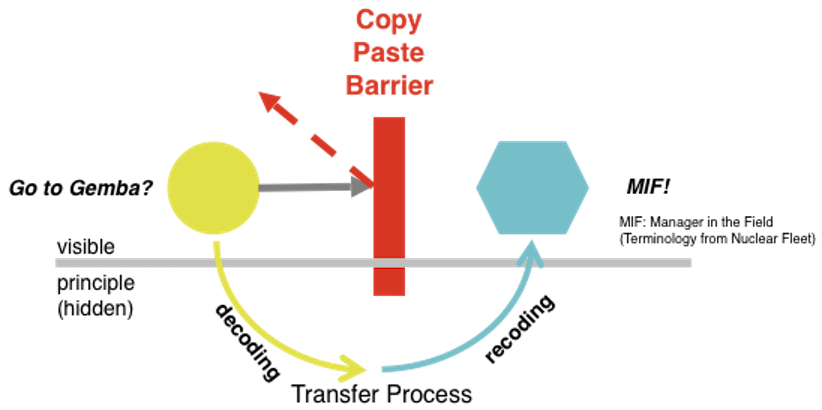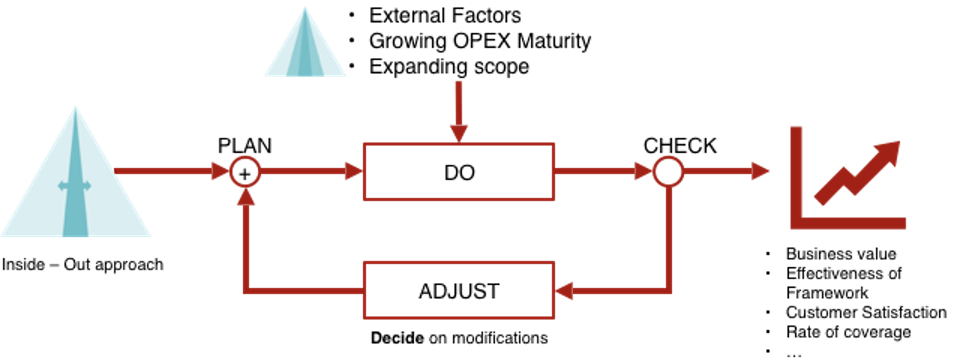Introduction
This article is a summary of a presentation made for the final assessment component of the LCS Level 3 Programme and puts into context five quintessential success factors for Operational Excellence programmes. These factors affect, to different degree, the three main phases of an OPEX programme, the Plan, Build, and Run phases. Two of the success factors, Empathy and Credibility, address the relationships to stakeholders in the business.
Two others, Impact and Dynamics, are very much focused on Performance against clear metrics, and the fifth, Integration, has both relationship and technical aspects.
Even though all five success factors are required, above all, OPEX programs have to be planned, built, and run in an emphatic manner by emphatic people.
Empathy is essential
Empathy can be defined as the capacity to place oneself in another’s position , in the context of this paper, regarding tools, trades, and technology as much as emotionally.
Empathy is essential, because application of empathy will contribute to overcoming two common challenges for every OPEX program: the Copy Paste Barrier and Systemic Inertia.
The Copy Paste Barrier
Across a number of different OPEX programs, the author observed what can be called the Copy Paste Barrier.

This effect denotes the difficulty to transfer OPEX concepts, ideas, tools and more from one business or functional domain to another. A quite obvious example is to attempt to transfer the notion of one piece flow from a production to an engineering environment. The engineering staff would reject the concept, if it is not decoded and recoded into the domain of engineering, with regards to terms, tools, trades, and technologies.
The barrier blocks a direct superficial transfer without re-coding, i.e. adopting the position of the target audience. A possible translation of one piece flow into the engineering domain is to say that each change to form, fit, or function of a part results into a new revision.
Systemic Inertia
Systemic Inertia results from the fundamental human need to satisfy the sense of belonging to a human system, such as a team, or any other organisational entity, such as a guild of a particular trade. Such human systems are established and upheld by common rules and behaviours. Conformity to these secures the belonging to the system, and hence establishes an inertia with respect to changes of any kind. In a professional context, this is, for example, resistance against changes in the way of working.
Empathy applies in all three phases of an OPEX program
The common place situation for any OPEX program today is that it is launched as an injection into existing, established, and successful company culture. As often as not, in particular the early stages are supported by external staff or staff specifically hired for the program that either way is not fully embedded into the systemic environment.
During the Plan phase, empathy is needed to establish a strong bond with the key stake holders in this phase: the Executive Committee and the most senior leadership. It is necessary to understand the particular expectations on the OPEX program, to translate the chosen overall approach into the language of the corporate business context, and to adapt to the overall communication style.
During Build phase, when the program plan is initially instantiated, it is vital to secure buy in from the early adopters of the OPEX program. Just like for any other customer experience, rejection by the early adopters will radiate faster and further than any positive experience. While this typically will not result directly in termination of an OPEX program, it will set the program significantly back, and recovery requires even more efforts, slowing the program down, i.e. delaying results.
Empathy will as well enable to understand potential flaws or shortcomings in the plan, i.e. aspects that do not work fully as expected, either technically or in terms of communication.
Understanding the actual performance, and moreover the root causes for shortcomings of the OPEX program carries over into the Run phase and has to be continued there.
Opex is about Impact
Often, OPEX programs are, at least initially, positioned as cultural change programs. However, inevitably, the question about impact, and in particular financial impact will arise, apparently within five years after launch. Impact is not necessarily cost reduction, it may as well be, for example, growth in market share, or increased profitability. Known leading indicators for economical success, such as Customer Satisfaction (e.g. Net Promoter Score) or Employ Satisfaction Indices may be included, but do not suffice in isolation.
Only if an OPEX program is directly and strongly linked to the particular impact ambitions of the corporation, it will continue to exist at times, when the competitive situation of the company is under pressure or during a general economical decline.
Establishment and Utilisation of essential OPEX program KPI
These particular impact ambitions have to be established on Executive Board level during Plan phase, and translated into the domain of every environment, where OPEX is launched. In particular over time, the impact objectives of the corporation may change, hence it is an essential task during the Run phase to regularly challenge OPEX objectives and contributions, and adjust to changes in the overall environment.
The outcome of this activity is a set of up to date, robust, and relevant Key Performance Indicators that have a vital role in the continuous PDCA of the OPEX program (see further below). Demonstration of performance against these KPI will be vital for the continuous support for the OPEX program by corporate management.
Position the OE program as an Integrator
Lean has since long jumped the borders of manufacturing and automotive industry. Nowadays we know of, for example, Lean for Public Services or Lean Software engineering. At the same time other concepts such as Agile, New Way of Working, Advanced Product Quality Planning, and many more emerge, and quickly spread beyond their domain origin. The common denominator of all is that they aim to improve performance, the discriminator lies in the means to achieve that. These discriminating means may be technical, e.g. specific tools or methods, or social, e.g. forming new organisational structures such as guilds, tribes etc.
Consequently, OPEX programs will find themselves in a position, where they will have to shape and explain their relationship to other corporate initiatives, which are eventually younger in corporate context, and potentially more attractive because of that. OPEX programs have to position themselves as open and integrative with regards to emerging concepts from the very start, for two reasons:
- Rivalry or even turf wars will alienate the line organisation and ultimately result in an either or decision, which at least limits the reach of both initiatives.
- Secondly, given that the common denominator is improvement, cooperation and integration should be a fundamental principle: it is not forbidden to apply Agile principles in Operational Excellence and vice versa.
Understanding synergies and embracing ideas in a branded framework
Empathy (see above) will enable to understand, how different ideas will support each other for the benefit of the corporation, and where aspects of one or the other may be more fitting to different parts of the business.
OPEX programs can make provisions to be an Integrator by designing their frameworks in an open, extensible manner, i.e. abstaining from an imperative and dogmatic stance. Frameworks should be branded to the corporation and covey two messages: „from us for us“ and „open, flexible, and extensible“. By these measures, integration is built into the framework and positions the OPEX program itself accordingly.
Build credibility based on Results
While every OPEX program should be clearly linked to top level business objectives and deliver positive impact on them (see above), these metrics are relevant predominantly at senior management level, to justify existence and continuation of the OPEX program. During deployment (Build and Run phases) it is necessary to make the program relevant to the specific target audience, answering the question: „what is in for me?“.
It can be regularly observed that practitioners, who already participated in the program can give more convincing testimony and hence create more buy-in to an OPEX program than external examples and theory. The reason for the by far higher effectiveness by credibility lies in the minimisation of the Copy-Paste Barrier and the proximity in the systemic environment.
The Inside-Out approach
OPEX programs can be designed in a way that such multipliers can be leveraged continually, using an Inside-Out approach. Typically, two options are discussed for deployment of an OPEX program: top-down and bottom-up. Both have advantages, and disadvantages, one of which is common to both: the challenge to transition to the next managerial tier: middle management.
The middle management tier in a corporation is, as a generalisation, a proverbial barrier or decelerator. The root cause for middle management to be reluctant to pick up on programs is that this group typically has to implement concurrent change initiatives coming from various functions into operational business, and at the same time keep the operational performance by and large un-affected. Middle management therefore usually makes trade off decisions as what to pursue with which priority.
The Inside-Out approach avoids this barrier by engaging a small, coherent vertical slice of the organisation all at once: from very senior level to front line, and explicitly including the middle management tier. The benefits of this approach are that due to a coherent target audience the technical aspects: tools, trades, and technology, as well as the systemic disposition are homogeneous, so that empathy can be applied more focused and effectively. Furthermore any challenges can be addressed at the right level, using escalation and delegation.
A practical example of the Inside-Out approach is to start within one engineering discipline with in the engineering directorate, then to gradually cover the disciplines, and crossing over to other domains such as procurement or production at the direct interfaces in processes.
Contribution of the Inside-Out approach to Credibility by Results
The Inside-Out approach creates consistent results in a rather short time frame. Though they have limited impact on the overall performance of the program and the key metrics initially, the Inside-Out approach should deliver significant results in the scope of the targeted slice of the organisation. First hand experience enables operational staff on all levels to spread the word about benefits and results through their own network.
The credibility of people within their community in combination with the tangible and relevant results will lower the entry threshold for the next vertical slice, and may even generate a pull. Result based Credibility aids the sustainment of momentum of any OPEX program.
Manage the dynamics
By design and intent, every OPEX program creates its own dynamics: As the maturity of the organisation increases in being operationally excellent, the needs change, for example:
- Capability building may have to be updated to provide more advanced tools and methods to solve more challenging and complex problems;
- Performance management may have to be enhanced, e.g. implementing a balanced scorecard system, as the understanding of the overall performance and dependencies matures;
- Rollout patterns may have to change, when end to end processes evolve as the more effective structure to allocate responsibilities than a strictly functional breakdown.
Next to these internal dynamics, the environment will have its own dynamics: the macro-economic conditions will change, mergers or acquisitions may re-arrange business priorities and so forth.
Consequently, when entering the Run phase, the OPEX program will have to be evaluated continuously against the business value it delivers, and whether the currently targeted business value is still appropriate. In other words, any OPEX program should apply the PDCA cycle onto itself, understand deviations from plans and metrics, and adjust the program accordingly.
This should go without saying, however OPEX programs sometimes forget to do as they preach.
Conclusion
This paper laid out five success factors for OPEX programs:
- Empathy is required in all stages of an OPEX program in order to be able to design, deploy, and sustain a program that truly fits the needs of the corporation in all its branches and is attractive.
- The definition and pursuit of Impact in terms of business value is essential for all OPEX programs. The fundamental notion is „We want to remain successful, not different“. The OPEX program must define SMART metrics to demonstrate its contribution to business value, and the resulting set must include and prioritise financial metrics.
- OPEX programs have to position themselves as Integrators. New ideas emerge constantly and provide an increasing wealth of ways to improve performance, each with unique features as well as commonalities with more seasoned approaches. OPEX programs have to be open for new ideas and pro-actively embed emerging ideas for the benefit of the corporation. This can best be achieved by a branded, declarative framework („from us for us, and flexible“)
- Credibility based on Results is a driver for successful deployment of OPEX programs. Using an Inside-Out approach by engaging a small but coherent vertical slice of the organisation, practical results can be generated in a short time frame. The people involved in their achievement will relay these via their network into the wider organisation. The high credibility of practitioners in their peer groups reduces the entry threshold for the OPEX program or may even create pull.
- High dynamics are natural for an OPEX program. PDCA has to be applied continually to validate the performance of the program against its impact targets and potential need for adaptation due to changing demand resulting from the program itself, as well as from changes in the wider environment.
Even though all five success factors are required, above all, OPEX programs have to be planned, built, and run in an emphatic manner by emphatic people.






